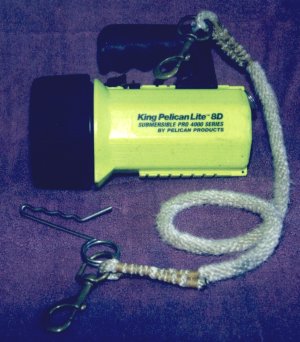Gear Lanyards

Chances are your light or other piece of gear came with a wrist lanyard. This item is probably ok for diving in the tropics where you shouldn't be doing anything with your hands anyway, but around here it is lousy. Wrist lanyards are a pain to put on and a pain to get off, and in the case of a light, if you let go of it to do something with both hands, it will invariably get in the way and bob around until it shines in your eyes and blinds you. When you finally get fed up with it, you will take it off, and in a careless moment, your equipment will be lost. Here is a much better rig, commonly known as a "hi-lo" lanyard:
Take the wrist lanyard off, and throw it away. Get two brass snaps and a piece of rope. Braided 1/2 " nylon is what I used because it is supple, won't rot, won't unravel, and doesn't float. Attach a brass snap to each end. You can just tie them on, or get fancy like me and make streamlined loops. The end-to-end length of mine is about four feet, including the snaps, but you can experiment. Attach the base ring of one of the brass snaps directly to your gear where the lanyard was.
When diving, simply clip the free end of the line to your BC or weight belt. Now there is no way you can accidentally unhook the light from the line, and you have a fastener right on the light so you can clip it on to you when you don't want to hold it, or just let it hang. This rig is very effective for a camera as well and would be for other things in general, although too many lines hanging around you would be a problem in itself. An important feature of this design is that if it should become an entrapment, it is easy to ditch it, unlike the old brass ring under the tank valve and rope over the shoulder rig. You can also move it around wherever you like.
Onshore, you can clip the two brass snaps together and sling the whole thing around your neck. For those long marches to and from the water, you can thread the line through your fin straps and any other accessories, which conveniently frees up your hands. You can tie a loose knot in the line to shorten it before climbing the ladder on a boat.
You might think that this system would be very tangle-prone, but from actual use, I can tell you that it is not. In the water, I usually have my main light permanently attached at the end of the line, and a goody bag and tickle stick clipped onto the light for quick easy access. If I am using a wreck reel, I usually clip it on also, so I do not have to worry about dropping it.
DIR
Well, this just looks like an entanglement hazard to me. Myself, I will take my chances with imaginary entanglements, and not lose my gear.

